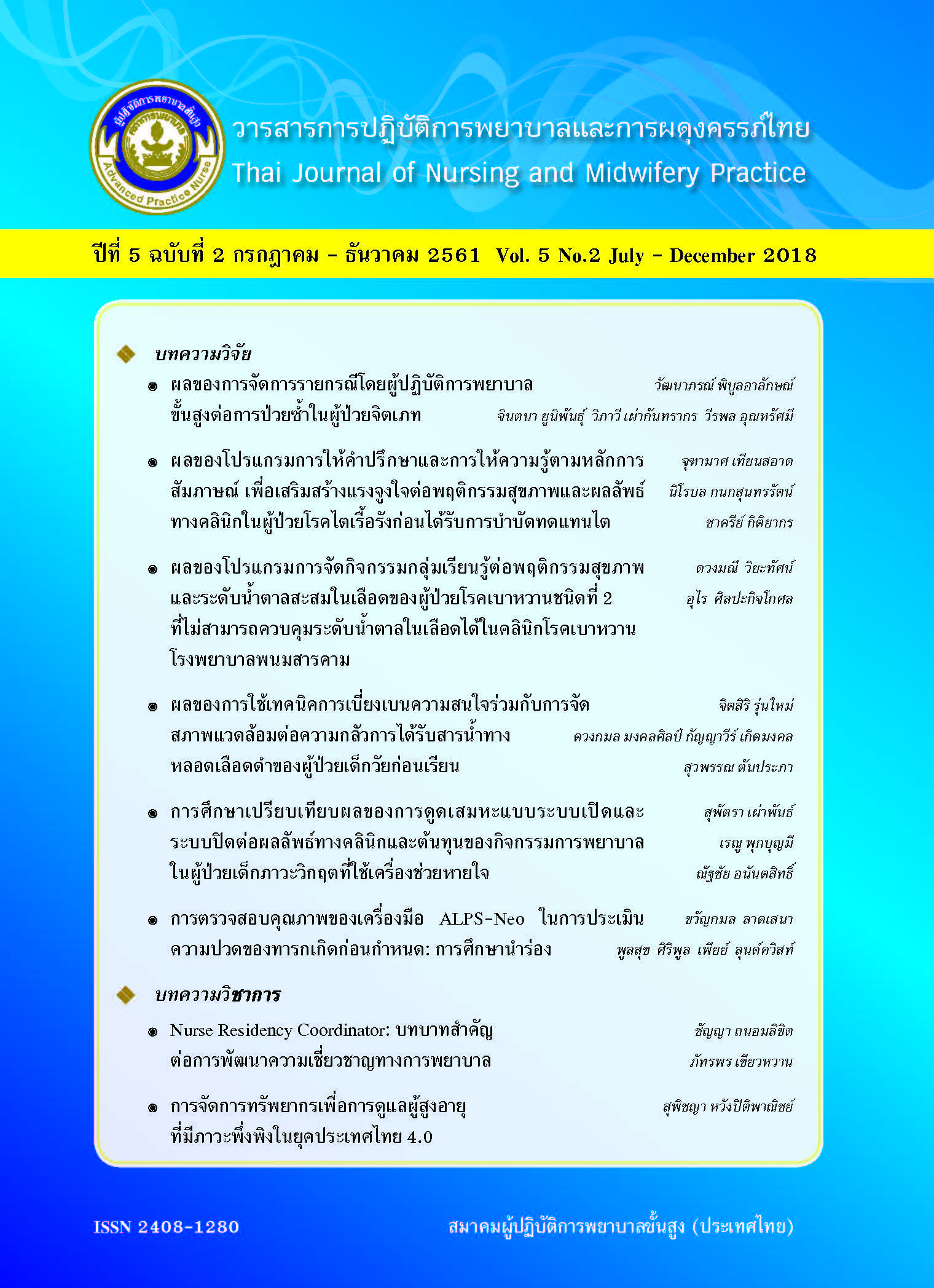A Comparison Study of Effects of Open and Closed Suctioning System on Clinical Outcomes and Cost of Nursing Activity-Based in Critically Ill Children with Mechanical Ventilation
Main Article Content
Abstract
This quasi experimental research with crossover design aimed to compare the effects of open and
closed suctioning system on clinical outcomes and cost of nursing activity-based in critically ill children with mechanical ventilation. Subjects were 23 pediatric patients, who were admitted to the pediatric intensive care unit during June1, to August 31, 2017. The inclusion criteria were critically ill children aged 1 month to 18 years, who received the endotracheal tube with mechanical ventilation and not received neuromuscular blocking agents. Randomization was performed with the use of a computer generated random sequence by a block of 4 either open or closed suctioning system methods. Subjects received endotracheal suctioning 92 episodes. The duration was at least 3 hours between another suctioning. Data were analyzed using descriptive statistics, Wilcoxon signed-rank test, and paired t-test. The findings of closed suctioning system showed that the median of change in heart rate, change in mean arterial pressure, and change in level of conscious was significantly lower than open suctioning system (p < .05). The mean of cost of nursing activity-based was significantly lower than open suctioning system (p < .05). The results of this study showed that using closed suctioning system was safe and cost effectiveness in caring pediatric patients with mechanical ventilation.
Downloads
Article Details
References
2. Pookboonmee R. Humanistic nursing approach in pediatric critical care. In: Vaicheeta S, Chaisupmongkollarp T, Pookboonmee R, editors. Advance pediatric critical care nursing. Bangkok; D-One books; 2008. P.36-45. (In Thai)
3. Pediatric intensive care unit of Ramathibodi Hospital. Statistics of pediatric intensive care unit; 2017. (In Thai)
4. Jarog D. Endotracheal tube: suctioning and care. In: Verger JT, Lebet RM, editors. AACN procedure manual for pediatric acute and critical care. St. Louis (London): Saunders Elsevier; 2008. P.5-16.
5. Couchman BA, Wetzig SM, Coyer FM, Wheeler MK. Nursing care of the mechanically ventilated patient: what does the evidence say? part one. Intensive Critical Care Nusing. 2007; 23(1): 4-14.
6. Chulay M, Seckel MA. Suctioning: endotracheal or tracheostomy tube. In: Wiegand DM, editors. AACN procedure manual for critical care. 6th ed. St. Louis (London): Saunders Elsevier; 2011. P.5-16.
7. Fisk, A. C. The effects of endotracheal suctioning in the pediatric population: An integrative review. Dimens Crit Care Nurs. 2018; 37(1), 44-56.
8. AARC Clinical Practice Guidelines. Endotracheal suctioning of mechanically ventilated patients with artificial airways 2010. Respir Care. 2010; 55(6): 758-64.
9. Bassi GL. Airway secretions and suctioning. In: Tobin MJ, editors. Principles and practice of mechanical ventilation. 3th ed. New York, NY: The McGraw-Hill Companies; 2013
10. Faraji A, Khatony A, Moradi G, Abdi A, Rezaei M. Open and closed endotracheal suctioning and arterial blood gas values: A single-blind crossover randomized clinical trial. Crit Care Res Pract. 2015: 1-7
11. Jantra M. Role of continuous infusion of sedation and anagesics in pediatric ICU. In: Staworn D, Eksin C, Samransamruajkit R, editors. Pediatric critical care: The essentials. Bangkok; Beyond enterprise; 2015. P. 214-220. (In Thai)
12. Gelinas C, Tousignant-Laflamme Y, Tanguay A, Bourgault P. Exploring the validity of the bispectral index, the critical-care pain observation tool and vital signs for the detection of pain in sedated and mechanically ventilated critically ill adults: a pilot study. Intensive Crit Care Nurs. 2011; 27(1): 46-52.
13. Sonmez Duzkaya, D., & Kuguoglu, S. Assessment of pain during endotracheal suction in the pediatric intensive care unit. Pain Manag Nurs. 2015; 16(1), 11-19.
14. Coleman RM, Tousignant-Laflamme Y, Ouellet P, Parenteau-Goudreault E, Cogan J, Bourgault P. The use of the bispectral index in the detection of pain in mechanically ventilated adults in the intensive care unit: a review of the literature. Pain Res Manag. 2015;20(1):e33-7
15. Faritous Z, Barzanji A, Azarfarin R, et al. Comparison of Bispectral index monitoring with the critical-care pain observation tool in the pain assessment of intubated adult patients after cardiac surgery. Anesth Pain Med. 2016; 6(4):e38334.
16. Vaicheeta S. Nursing management in pediatric with mechanical ventilation. In: Vaicheeta S, Chaisupmongkollarp T, Pookboonmee R, editors. Advance pediatric critical care nursing. Bangkok; D-One books; 2008. P.135-154. (In Thai)
17. Evans, J., Syddall, S., Butt, W., & Kinney, S. Comparison of open and closed suction on safety, efficacy and nursing time in a paediatric intensive care unit. Aust Crit Care. 2014; 27(2), 70-74; quiz 75-76.
18. Johnson KL, Kearney PA, Johnson SB, Niblett JB, MacMillan NL, McClain RE. Closed versus open endotracheal suctioning: costs and physiologic consequences. Crit Care Med. 1994; 22(4): 658-66.
19. Seyyed Mazhari M., Pishgou’ei A. H., Zareian A., & Habibi H. Effect of open and closed endotracheal suction systems on heart rhythm and artery blood oxygen level in intensive care patients. Iran J Crit Care Nurs. 2010; 2(4), 1-2.
20. Evans, J., Syddall, S., Butt, W., & Kinney, S. Comparison of open and closed suction on safety, efficacy and nursing time in a paediatric intensive care unit. Aust Crit Care. 2014; 27(2), 70-74; quiz 75-76.
21. Ozden D, Gorgulu RS. Effects of open and closed suction systems on the haemodynamic parameters in cardiac surgery patients. Nurs Critl Care. 2015; 20(3): 118-25.
22. Ugras, G. A., & Aksoy, G. The effects of open and closed endotracheal suctioning on intracranial pressure and cerebral perfusion pressure: A crossover, single blind clinical trial. J Neurosci Nurs. 2012; 44(6), E1-E8.
23. Dastdadeh, R., Ebadi, A., & Vahedian-Azimi, A. Comparison of the effect of open and closed endotracheal suctioning methods on pain and agitation in medical ICU patients: A clinical trial. Anesth Pain Med. 2016; 6(5), e38337.
24. Acikgoz A, Yildiz S. Effects of open and closed suctioning systems on pain in newborns treated with mechanical ventilation. Pain Manag Nurs. 2015; 16(5): 653-63.
25. Afshari A, Safari M, Oshvandi K, Soltanian AR. The effect of the open and closed system suctions on cardiopulmonary parameters: time and costs in patients under mechanical ventilation. Nurs Midwifery Stud. 2014, 3(2): 1-6.


